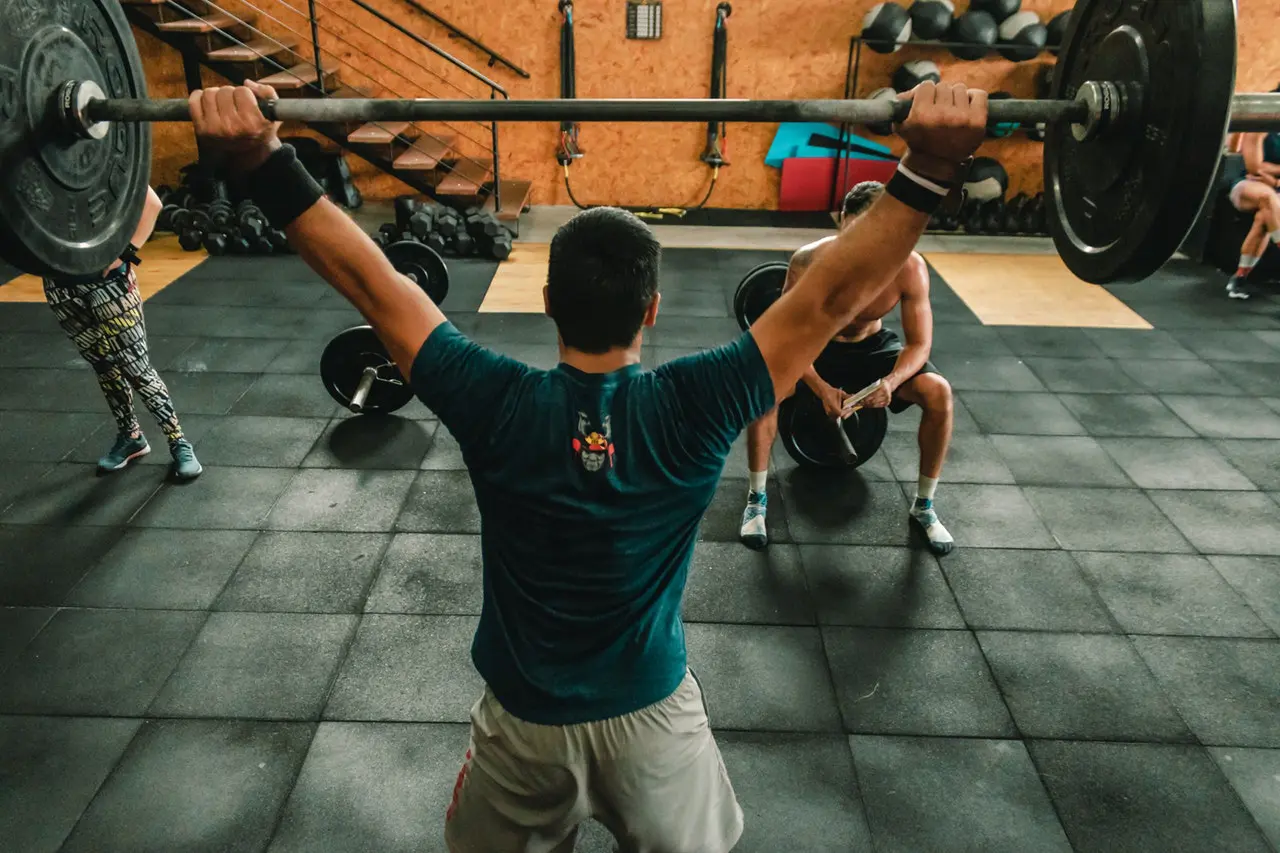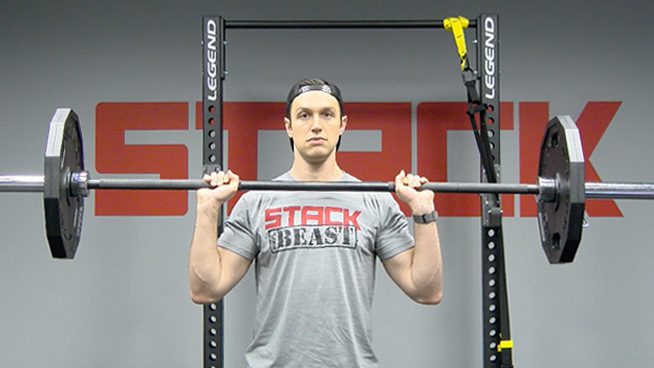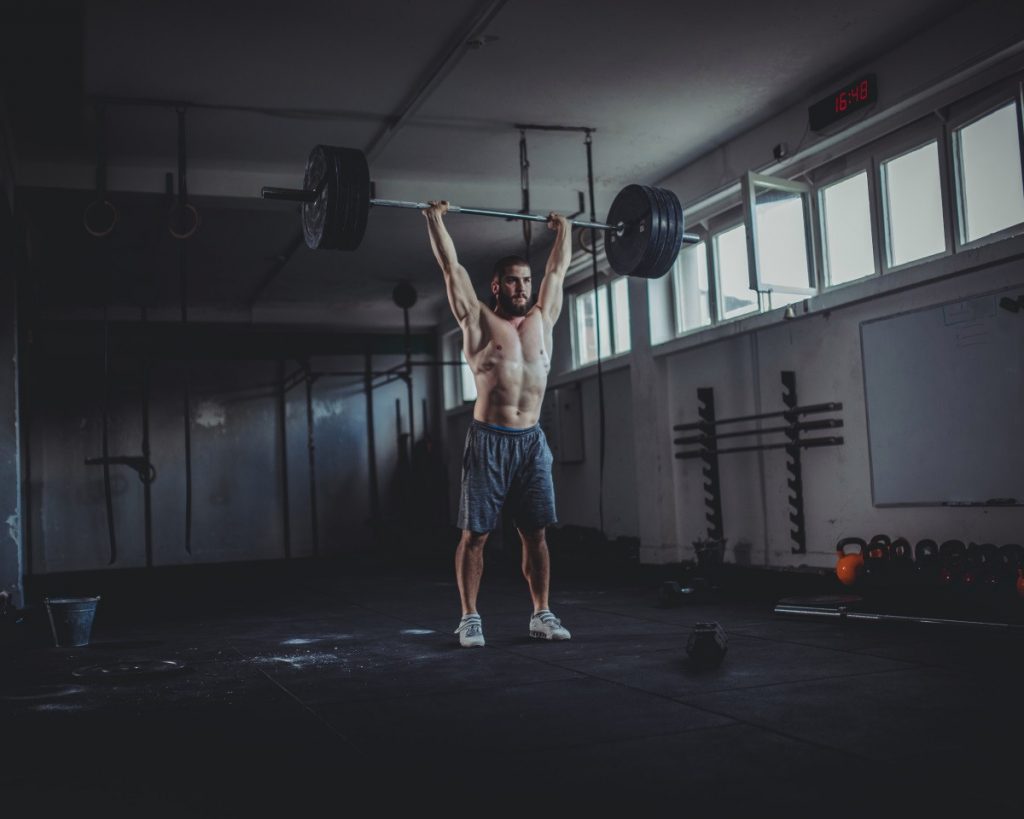
The best online fitness resource you'll ever need. We filter out the BS to ensure you meet your health and fitness goals!

The best online fitness resource you'll ever need. We filter out the BS to ensure you meet your health and fitness goals!

The overhead press is one of the Big Four barbell movements, alongside the squat, bench press and deadlift. It is a type of shoulder press with quite a few variations, though all of them bear similar hallmarks and all variations will benefit from the advice we will be laying out below.
Whether you’re training for aesthetic purposes, or to improve your strength and performance, there is a lot to be gained from regularly including overhead press variations in your routine.
The overhead press is a full body, compound exercise. This means that it uses multiple joints and muscle groups, and therefore recruits and stimulates a great deal of muscle fibre. Though the overhead press and its variations are mostly commonly used to elicit strength and hypertrophy gains in your shoulders and arms, there is a lot more at work throughout your body as you perform it. Your legs should be active and tense throughout.
If you’re performing a strict press, they should be bringing tension to the lift and keeping you balanced. If not, they will be used for a little push, adding power to the bar whilst simultaneously keeping you stable. Your core and lower back take a lot of strain as the downward pressure from the bar hits them. As antagonists and further stabilisers, your lats and biceps take a lot of isometric tension.
Essentially, there are few movements you can perform in the gym that will stimulate as much muscle mass as the overhead press, and there are few upper body movements that can elicit so much in regards strength gains and hypertrophy.
There are ways of performing the overhead press in order to maximise the weight involved and the hypertrophy and strength gains that follow. We will look at some of these today, showing you how to best control the movement and add weight to the bar.
However, first we will need to know what goes into the overhead press: what muscles are used, how is it performed, and is your form where it needs to be? When we know these things, we will be able to see what best to tweak to bring it up to par with where you want it.
The most prominent movers will be your shoulders, particularly your anterior deltoids, and your triceps. Performing the overhead press will lead to a great deal of growth across these muscle groups and will greatly enhance your pressing strength, with carryover to other movements like the bench press and dip. In addition, you biceps will be stimulated as antagonists, controlling the bar path, as will your upper back and core as both support the weight.
If you perform a conventional, standing overhead press variation with a barbell, there actually won’t be many muscles left out from the movement. It takes so much motor control and muscular tension to stabilise your body beneath the kinds of weight that a barbell overhead press makes use of that every muscle fibre in your body should ultimately be recruited in one way or another.
All of this will combine to give you solid foundational strength, a great variety of mind-muscle connectivity, and some huge upper body gains in strength and hypertrophy. The overhead press is a key part of many strength programs, and it will be rare to find an accomplished strongman or powerlifter who doesn’t perform it to an impressive degree.
Your overhead press will never be your heaviest lift- nor should it be. You will be using much smaller muscles, and far fewer active movers, in a far less mechanically stable position, than you will with other lifts. Your overhead press will be the weakest (or, perhaps, the least strong) of the Big Four lifts, with you bench press being a fair amount heavier and your squat and deadlift being a lot heavier.

Gains may also come quite slowly with the overhead press. Rather than adding a couple of 20kg plates every few weeks or months, you’ll be reaching for the 2.5- and 5-kilogram plates to measure your progress.
This is all good- it’s how it should be. Don’t let it put you off. If anything, it being hard to move significant weight, and to build to significant weight, is a sign of the overhead press’ efficacy. It is a difficult move and practising it will ultimately make you a stronger athlete.
However, there are some things you can do immediately to ramp up your overhead press and begin the long journey towards reaching your potential, which we will look at in detail a little later on.
The overhead press relies on good form to work, perhaps more so than any other lift. It’s very hard to cheat a strict overhead barbell press, and few variations will be particularly forgiving. The better your form is, the more weight you will move, and the faster you will progress. With this in mind, let’s do it right from the start: let’s get your form on the right track.
If you do the overhead press correctly, with good form and all the rudiments of progressive overload and recovery in place, you should find your upper body swelling into a prefect triangle of stable, muscular greatness. If you do it with bad form, however, you may be begging for a trip to your physio or the emergency room (you’ll be lifting more than your bodyweight directly above your head within a relatively short amount of time- it doesn’t usually go wrong, but if it does, it can go really wrong.)
Such extreme situations are, of course, rare. Mostly, a lapse in good form will result in missed lifts and missed opportunities for growth and strength gains.
Really nailing overhead press form is a project that can take years- decades, even. Accomplished lifters still seek perfection, and still work on their form week-by-week. It’s the only way to improve- the only way, ultimately, to push bigger numbers and add strength and muscle to your body.
Here’s how to overhead press properly:
Though there is no shortcut to building strength and putting on muscle, there are things you can do today that will make your overhead press immediately stronger, things that will improve your long-term technique and the improved results that come from such proficiency.
There are many facets and elements that will go into making a good lift. There are many that go into ensuring that your overhead press looks and performs how it should. However, there are four tips to take note of that stand above the rest; missing one could be the difference between sub-par performance and top-quality lifting.

Breathing and bracing is the most important thing you can do to improve every single lift and keep yourself safe in the gym. Whatever else you take from this article- if you take nothing else from this article- please bear this in mind. You need to make sure that you breathe and brace properly for every set of every rep of every exercise you perform in every workout: it’s that vital.
You have to work on perfecting your breathe and brace. If you don’t, it doesn’t matter how much muscle you put on, how hard you train, how perfect you keep your diet: every lift you perform will be like building a house on quicksand. With nothing to base it on and keep it stable, each lift will be doomed to inefficiency and weakness. You will have nothing to push against, and the bar will not move.
Breathe and brace before you approach the bar, taking a great bellyful of air. Practice crocodile breathing, and practice keeping tension throughout your entire lift. Rebreathe at the top of every lift if you need to, but try to get your whole set out of one breath (this should be doable for 1-3 reps.) With a stable core structure in place, every ounce of strength your surrounding muscles generate will be brought to bear: they will transfer into the bar and the ground, pushing them apart so that the lift goes exactly how you want it to.
As the overhead press is a full body exercise, you need to use your full body to make it work. Breathing and bracing will keep your core and trunk engaged, but what about your legs? Your braced core will in part be transferring your legs’ strength upwards, into your torso, so let’s make sure they are providing that strength whilst doing their own bit to keep the lift stable.
We’re mainly looking at your quads and glutes, here.
The glutes are easy. For strict presses, keep them tight. Flex them as you approach the bar, and don’t let them lose that tension. For leg drive, tense them as you take the bar, tighten them again at the bottom, but let them loosen a little as you flow through the push.
Your quads will be most relevant in overhead press variations in which leg drive is used. Push presses, some dumbbell overhead presses, Olympic moves like jerks and so on all need them, so you need to make sure you’re able to make use of this power.
Whilst your glutes are great for keeping you stable, you don’t want to have them being too active, as many people are prone to doing. It’s common enough to see people hinging their hips back before exploding the bar upwards, using their glutes for a snapping force akin to a deadlift.
This takes the bar out of the lifter’s centre of gravity and adds very little to the upward force we want to see.
Rather than doing this, try breaking at the knees, pushing them a little bit forwards and a little bit outwards. This will make better use of your quads than your glutes. It will keep the bar in your centre of gravity and will allow your legs to help generate the thrust upwards without having to compensate for any wobbles.

Another mistake that it’s all-too common to see in lifters is an overly wide grip.
Lifters seek to make the bar path shorter- thus reducing how far they have to push it- by taking their hands outwards towards the pates and increasing the angle from their shoulders.
This is a mistake. A closer grip is much more efficient. Though you will end up with your bar path being a couple of inches longer, you will be able to get a lot more muscle mass and contractile strength behind it. Aiming for just outside of shoulder width should do it- a centimetre or two out on either side will be perfect.
Keeping this grip width will bring a couple of advantages.
Your deltoids are tiny compared to other muscles- hence the overhead press will never be your strongest lift. However, there are muscles involved in the overhead press other than your shoulders: your triceps play a big part, and these meaty movers need to be brought in as much as possible. A closer grip will give you a lot more triceps activation and power, helping to generate that upward thrust.
Your latissimus dorsi will also become more available as a grounding support with a closer grip. You will be able to keep your elbows tucked in and facing forwards, which will naturally give you greater access to lat tension. Your lift will be more stable, and its descent will be more under your control, by doing this.
Aside from this, a wide grip can achieve the same result as breaking at the hips: it will throw your centre of gravity off and make controlling the bar path that much harder. It’s rare to see wonky pillars in classical architecture. There is a reason for this. Imagine a pole running through the top of your head, to the ground, perfectly perpendicular to the ground: this is your centre of gravity, and to support any amount of weight above your head, you need to support it through this line, much as that column needs to best support its roof.
You want to keep the weight along this line as much as possible: having your forearms parallel with this line will do this. Your forearms will only really be parallel at a certain width grip- which will be quite close. Outside of this, your elbows will flare, and it will be harder to maintain this motion and structural integrity will be disturbed. The roof will fall.

This is a little personal, as some people- including top lifters and strongmen- may find the opposite to be true. However, it holds true for most, and so is well worth trying out if you’re struggling to maintain a strong, true bar path that makes the most out of the power you’re putting behind it.
It is quite a common mistake to see people keeping their heads forwards as they lift through the overhead press. The most extreme result of this- which is never correct- is to see them push the bar around their faces in a curved path. Straight bar paths are always stronger, and you want to move your body around the bar instead of moving the bar around your body like this.
This being said, there are a couple of ways to get your face out of the way and maintain a straight bar path. The first, which is often sub-optimal, is to look up as you lift. This gets your face and chin out of the way, and then you can look forwards once more when the bar is over your head.
The better way to do it- which will better maintain your centre of gravity and allow for more coherent coordination- is to keep your head retracted, tucked back in a double chin. Though you may not look your best, you will create a natural shelf for the bar with your chest, you will allow your triceps to get under the bar, and you will keep your body moving more fluidly around the bar.
At the top of the lift, move your head forwards to complete the lift, keeping the bar in your centre of gravity as you lockout. Think of it like this: one of my favourite analogies is to think of opening a window and sticking your face out. The bar is the window, push it up, then stick your face through. You will find strength and stability at the top where previously there wasn’t much of either.
That completes our top four tips for improving your overhead press. They can all be implemented immediately- though they may each take a little practice- and can be incorporated into your lifting practice without any programming changes.
Though progress is usually about progressive overload, dietary fulfilment, stimulation and rest, sometimes subtle changes like the ones in our list are the ones that make the difference. Certainly, implementing them will add a fair amount of weight to the bar straight away, without any gains to muscle mass or contractile strength. From here, you will be under greater stimulation, which will put you into a virtuous cycle with added load.
Try them out, see how they can work for you, and enjoy as you suddenly become a much stronger overhead presser, overnight.